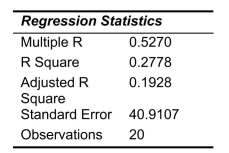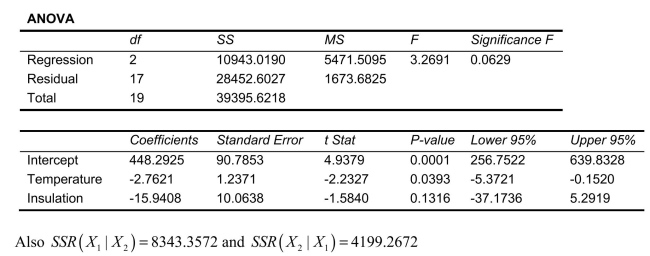Multiple Choice
SCENARIO 14-6 One of the most common questions of prospective house buyers pertains to the cost of heating in dollars (Y) .To provide its customers with information on that matter, a large real estate firm used the following 2 variables to predict heating costs: the daily minimum outside temperature in degrees of Fahrenheit  and the amount of insulation in inches
and the amount of insulation in inches  Given below is EXCEL output of the regression model.
Given below is EXCEL output of the regression model. 

-Referring to Scenario 14-6, what can we say about the regression model?
A) The model explains 17.12% of the variability of heating costs; after correcting for the degrees of freedom, the model explains 27.78% of the sample variability of heating
Costs.
B) The model explains 19.28% of the variability of heating costs; after correcting for the degrees of freedom, the model explains 27.78% of the sample variability of heating
Costs.
C) The model explains 27.78% of the variability of heating costs; after correcting for the degrees of freedom, the model explains 19.28% of the sample variability of heating
Costs.
D) The model explains 19.28% of the variability of heating costs; after correcting for the degrees of freedom, the model explains 17.12% of the sample variability of heating
Costs.
Correct Answer:

Verified
Correct Answer:
Verified
Q26: SCENARIO 14-4<br>A real estate builder wishes to
Q68: SCENARIO 14-4<br>A real estate builder wishes to
Q112: SCENARIO 14-8<br>A financial analyst wanted to examine
Q138: SCENARIO 14-4<br>A real estate builder wishes to
Q302: SCENARIO 14-19 The marketing manager for a
Q303: SCENARIO 14-1 A manager of a product
Q304: SCENARIO 14-19 The marketing manager for a
Q308: SCENARIO 14-5 A microeconomist wants to determine
Q309: SCENARIO 14-8 A financial analyst wanted to
Q310: SCENARIO 14-9 You decide to predict gasoline